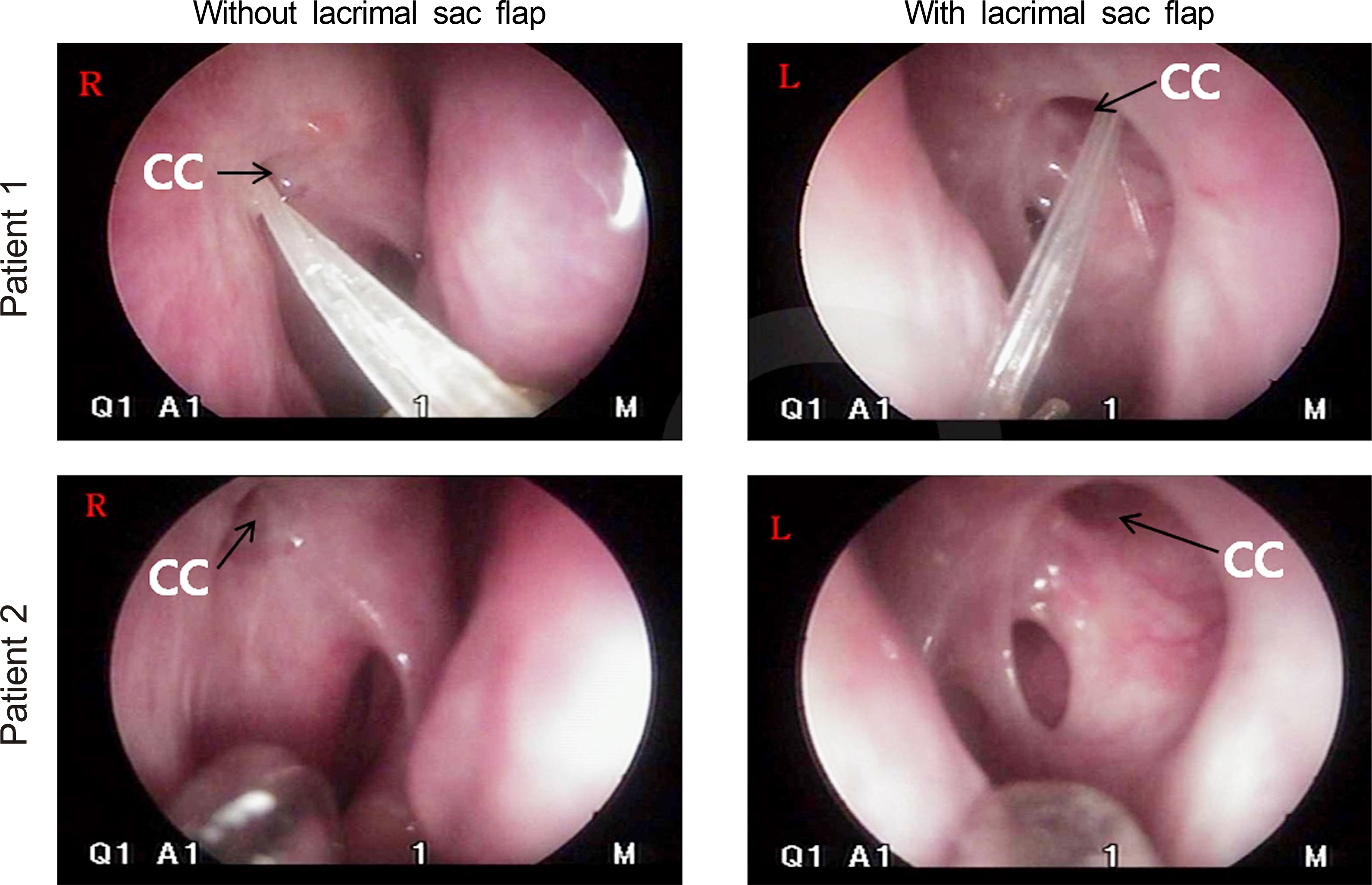J Korean Ophthalmol Soc.
2011 Dec;52(12):1391-1398. 10.3341/jkos.2011.52.12.1391.
Results of Endonasal Dacryocystorhinostomy with Lacrimal Sac Flap and Silastic Sheet
- Affiliations
-
- 1Department of Ophthalmology, Maryknoll Medical Center, Busan, Korea. eyerheu@hanafos.com
- KMID: 2215140
- DOI: http://doi.org/10.3341/jkos.2011.52.12.1391
Abstract
- PURPOSE
To investigate postoperative outcomes of endonasal dacryocystorhinostomy (DCR) using lacrimal sac flap and silastic sheet in patients with acquired nasolacrimal duct obstruction.
METHODS
From November 2009 until December 2010, endonasal DCR with lacrimal sac flap was performed in 26 eyes (group 1) and conventional DCR without flap in 28 eyes (group 2). The anatomic and functional success rates and complications were analyzed and compared between the 2 groups.
RESULTS
The anatomical success rate was 96.2% in group 1 and 85.7% in group 2. The functional success rate was 100% in group 1 and 92.9% in group 2. The success rate was higher in group 1 than in group 2, although not being statistically significant. Granuloma was found in 15.4% of patients in group 1 and 32.1% of patients in group 2. Synechia or membranous obstruction was not found in group 1, whereas synechia developed in 14.3% of patients in group 2.
CONCLUSIONS
Endonasal DCR with lacrimal sac flap showed a greater success rate and lower formation of granuloma than conventional endonasal DCR without flap because of reduced inflammation and granulation tissue formation around retained bony spicles.
MeSH Terms
Figure
Reference
-
References
1. Caldwell GW. Two new operations for obstruction of the nasal duct with preservation of the canaliculi and an incidental description of a new lachrymal probe. NY Med J. 1983; 57:581.2. McDonogh M, Meiring JD. Endoscopic transnasal dacryocystorhinostomy. J Laryngol Otol. 1989; 103:585–7.
Article3. Jin HR, Yeon JY, Choi MY. Endoscopic dacryocystorhinostomy: creation of a large marsupialized lacrimal sac. J Korean Med Sci. 2006; 21:719–23.
Article4. Rebeiz EE. Endoscopic dacryocystorhinostomy. Curr Opin Otolaryngol Head Neck Surg. 1999; 7:44–9.
Article5. Onerci M, Orhan M, Ogretmenoğ lu O, Irkec M. Long-term results and reasons for failure of intranasal endoscopic dacryocystorhinostomy. Acta Otolaryngol. 2000; 120:319–22.6. Durvasula VS, Gatland DJ. Endoscopic dacrocystorhinostomy: lont-term results and evolution of surgical technique. J Laryngol Otol. 2004; 118:628–32.7. Tsirbas A, Wormald PJ. Endonasal dacryocystorhinostomy with mucosal flaps. Am J Ophthalmol. 2003; 135:76–83.8. Munk PL, Lin DT, Morris DC. Epiphora: treatment by means of dacryocystoplasty with balloon dilatation of the nasolacrimal drainage apparatus. Radiology. 1990; 177:687–90.9. Zílelíoğ lu G, Tekeli O, Uğ urba SH, et al. Results of endoscopic endonasal non-laser dacryocystorhinostomy. Doc Ophthalmol. 2002; 105:57–62.10. Mandeville JT, Woog JJ. Obstruction of the lacrimal drainage system. Curr Opin Ophthalmol. 2002; 13:303–9.
Article11. Lee TS, Shin HH, Hwang SJ, Baek SH. The results of revision surgery for the failed endonasal DCR. J Korean Ophthalmol Soc. 2007; 48:186–92.12. Sham CL, van Hasselt CA. Endoscopic terminal dacryocystorhinostomy. Laryngoscope. 2000; 110:1045–9.
Article13. Wormald PJ. Powered endoscopic dacryocystorhinostomy. Laryngoscope. 2002; 112:69–72.
Article14. Rhee KC, Lee TS. The effect of mitomycin-C eyedrop on pre-vention of internal ostium obstruction after endonasal dacryocystorhinostomy. J Korean Ophthalmol Soc. 1998; 49:2923–7.15. Weidenbecher M, Hosemann W, Buhr W. Endoscopic endonasal dacryocystorhinostomy: Results in 56 patients. Ann Otol Rhinol Laryngol. 1994; 103:363–7.
Article16. Tsirbas A, Wormald PJ. Mechamical endonasal dacryocystorhinostomy with mucosal flaps. Br J Ophthalmol. 2003; 87:43–7.17. Massegur H, Trias E, Ademà JM. Endoscopic dacryocystorhinostomy: Modified technique. Otolaryngol Head Neck Surg. 2004; 130:39–46.
Article18. Kansu L, Aydin E, Avci S, et al. Comparison of surgical outcomes of endonasal dacryocystorhinostomy with or without mucosal flaps. Auris Nasus Larynx. 2009; 36:555–9.
Article19. Codère F, Denton P, Corona J. Endonasal dacryocystorhinostomy: a modified technique with preservation of the nasal and lacrimal mucosa. Ophthal Plast Reconstr Surg. 2010; 26:161–4.
Article20. Yuen KS, Lam LY, Tse MW, et al. Modified endoscopic dacryocystorhinostomy with posterior lacrimal sac flap for nasolacrimal duct obstruction. Hong Kong Med J. 2004; 10:394–400.21. Dhanasekar G, Umapathy N, Dapling RB, Skinner DW. Short-term results of endonasal dacryocystorhinostomy with a mucosal flap and a bone dissection technique. J Otolaryngol Head Neck Surg. 2009; 38:390–4.22. Trimarchi M, Giordano Resti A, Bellini C, et al. Anastomosis of nasal mucosal and lacrimal sac flaps in endoscopic dacryocystorhinostomy. Eur Arch Otorhinolaryngol. 2009; 266:1747–52.
Article
- Full Text Links
- Actions
-
Cited
- CITED
-
- Close
- Share
- Similar articles
-
- A Silastic Sheet found during Endoscopic Transnasal Dacryocystorhinostomy for Acute Dacryocystitis
- Success Rate of Endonasal Dacryocystorhinostomy Based on the Location of the Lacrimal Sac
- Outcome of Endonasal Dacryocystorhinostomy with Nasal and Lacrimal Sac Mucosal Flaps
- Clinical Outcomes of Endonasal Dacryocystorhinostomy Using Fibrin Glue for Lacrimal Sac and Nasal Mucosal Flaps
- The Correlation between Organisms Cultured from the Lacrimal Sac and Lacrimal Punctum in Dacryocystitis




